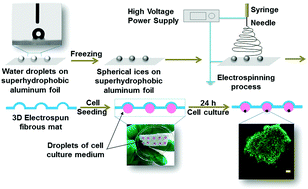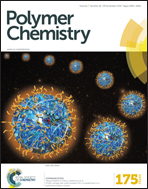Facile fabrication of a 3D electrospun fibrous mat by ice-templating for a tumor spheroid culture†
Abstract
Electrospinning technology is a simple, convenient, and cost-effective method to fabricate nano/micro fibrous materials. Electrospun fibers are generally collected as a two-dimensional (2D) mat, which lacks a complex and macroscopic three-dimensional (3D) structure. In this work, we fabricated polycaprolactone (PCL) electrospun fibrous materials with small wells (wPCL) by using icy balls as templates. A cooling system was designed and incorporated into the electrospinning setup to achieve our goal. The size and distances between the wells can be easily controlled by a simple water spotting process. When we added cell culture medium droplets into the fabricated wells and placed them upside down, we found that the structure could stabilize the droplets against small mechanical shocks and perturbations, which makes it a good platform for a 3D spheroid culture by the hanging droplet method. Furthermore, the fibrous nature of the electrospun mat ensured the better exchange of O2 and CO2 between the droplet and surrounding environment. We also demonstrated that the cubic and triangle shaped 3D electrospun fibrous mat can be fabricated using a similar methodology. Our results indicate that electrospinning technology involving ice-templated collection is a mild and straightforward way to fabricate 3D electrospun materials and can be readily used for a 3D cell culture.


 Please wait while we load your content...
Please wait while we load your content...